Attached files
| file | filename |
|---|---|
| EX-99.2 - EX-99.2 - Wave Life Sciences Ltd. | d495597dex992.htm |
| 8-K - 8-K - Wave Life Sciences Ltd. | d495597d8k.htm |
Exhibit 99.1
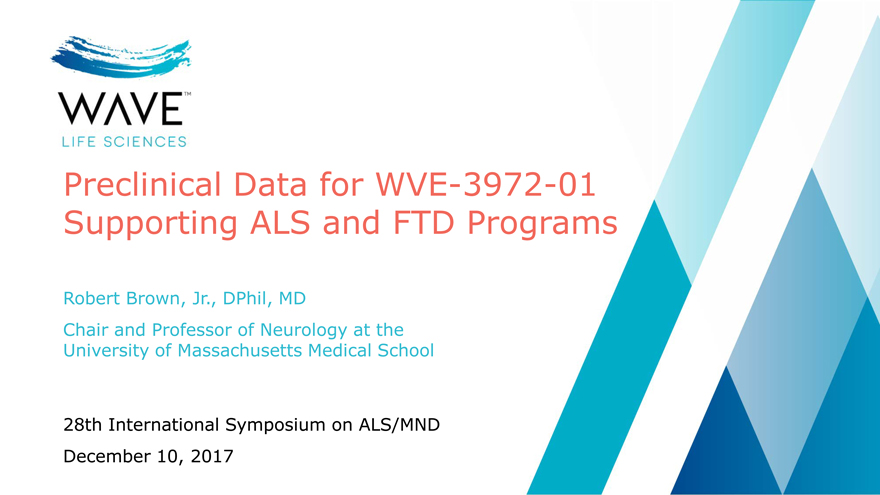
Preclinical Data for
WVE-3972-01 Supporting ALS and FTD Programs
Robert Brown, Jr., DPhil, MD
Chair and Professor of Neurology at the University of Massachusetts Medical School
28th International Symposium on ALS/MND December 10, 2017
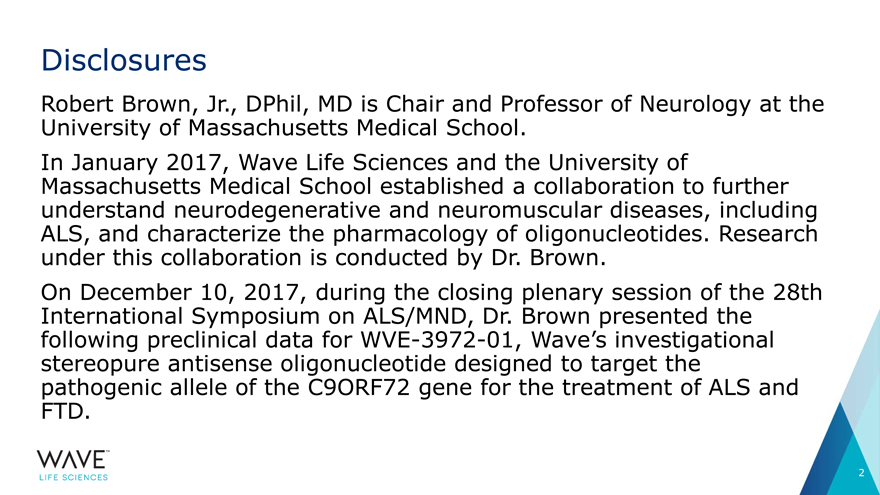
Disclosures
Robert Brown,
Jr., DPhil, MD is Chair and Professor of Neurology at the University of Massachusetts Medical School.
In January 2017, Wave Life Sciences and the University of
Massachusetts Medical School established a collaboration to further understand neurodegenerative and neuromuscular diseases, including ALS, and characterize the
pharmacology of oligonucleotides. Research under this collaboration is conducted by Dr. Brown.
On December 10, 2017, during the closing plenary session
of the 28th International Symposium on ALS/MND, Dr. Brown presented the following preclinical data for WVE-3972-01, Wave’s investigational stereopure antisense
oligonucleotide designed to target the pathogenic allele of the C9ORF72 gene for the treatment of ALS and FTD.
2
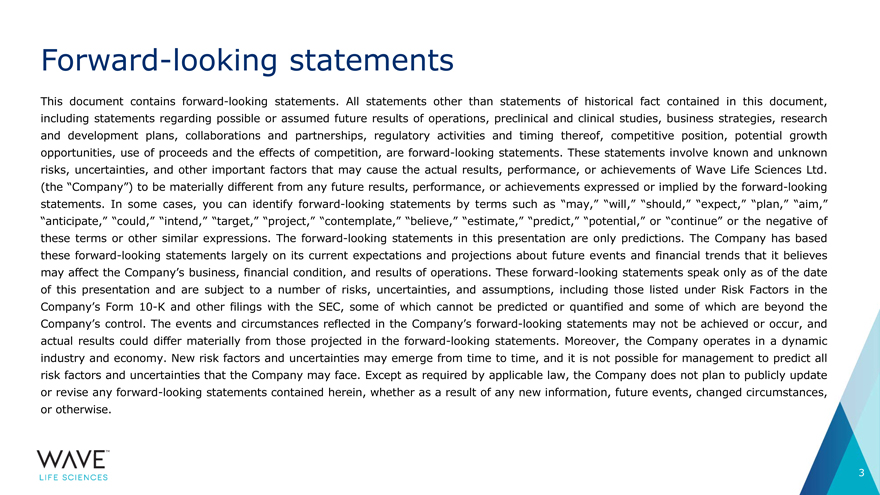
Forward-looking statements
This document contains forward-looking statements. All statements other than statements of historical fact contained in this document, including statements
regarding possible or assumed future results of operations, preclinical and clinical studies, business strategies, research and development plans, collaborations and partnerships, regulatory activities and timing thereof, competitive position,
potential growth opportunities, use of proceeds and the effects of competition, are forward-looking statements. These statements involve known and unknown risks, uncertainties, and other important factors that may cause the actual results,
performance, or achievements of Wave Life Sciences Ltd. (the “Company”) to be materially different from any future results, performance, or achievements expressed or implied by the forward-looking statements. In some cases, you can
identify forward-looking statements by terms such as “may,” “will,” “should,” “expect,” “plan,” “aim,” “anticipate,” “could,” “intend,” “target,”
“project,” “contemplate,” “believe,” “estimate,” “predict,” “potential,” or “continue” or the negative of these terms or other similar expressions. The forward-looking statements
in this presentation are only predictions. The Company has based these forward-looking statements largely on its current expectations and projections about future events and financial trends that it believes may affect the Company’s business,
financial condition, and results of operations. These forward-looking statements speak only as of the date of this presentation and are subject to a number of risks, uncertainties, and assumptions, including those listed under Risk Factors in the
Company’s Form 10-K and other filings with the SEC, some of which cannot be predicted or quantified and some of which are beyond the Company’s control. The events and circumstances reflected in the
Company’s forward-looking statements may not be achieved or occur, and actual results could differ materially from those projected in the forward-looking statements. Moreover, the Company operates in a dynamic industry and economy. New risk
factors and uncertainties may emerge from time to time, and it is not possible for management to predict all risk factors and uncertainties that the Company may face. Except as required by applicable law, the Company does not plan to publicly update
or revise any forward-looking statements contained herein, whether as a result of any new information, future events, changed circumstances, or otherwise.
3
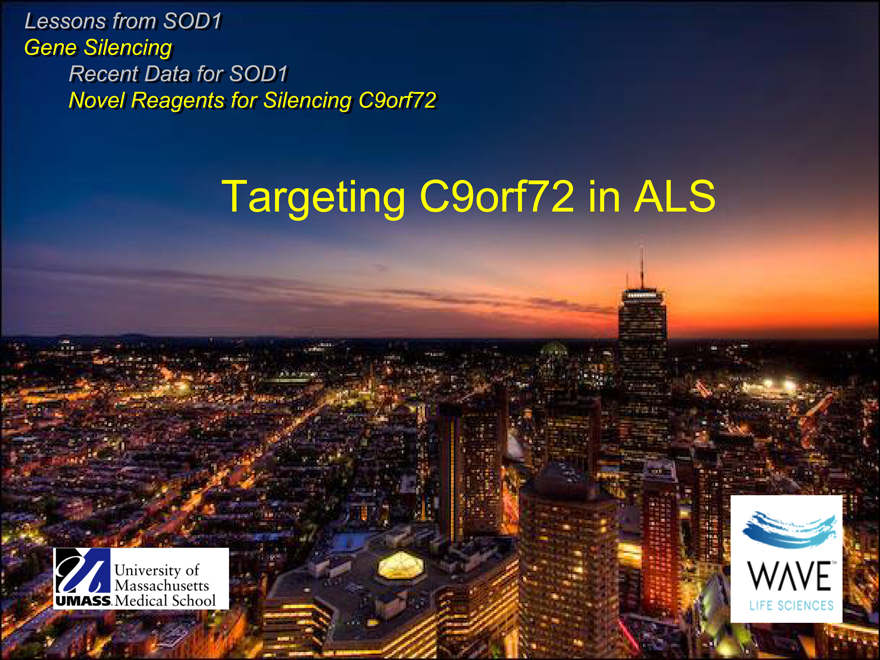
Lessons from SOD1 Gene Silencing
Recent Data for SOD1
Novel Reagents for Silencing C9orf72
Targeting C9orf72 in ALS
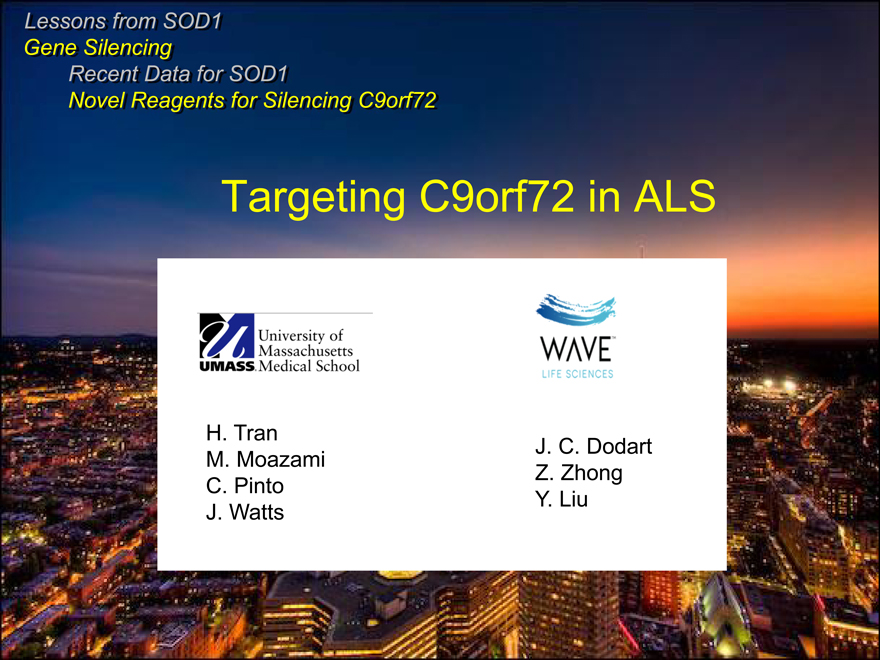
Lessons from SOD1 Gene Silencing
Recent Data for SOD1
Novel Reagents for Silencing C9orf72
Targeting C9orf72 in ALS
H. Tran
J. C. Dodart M. Moazami Z. Zhong C. Pinto Y. Liu J. Watts
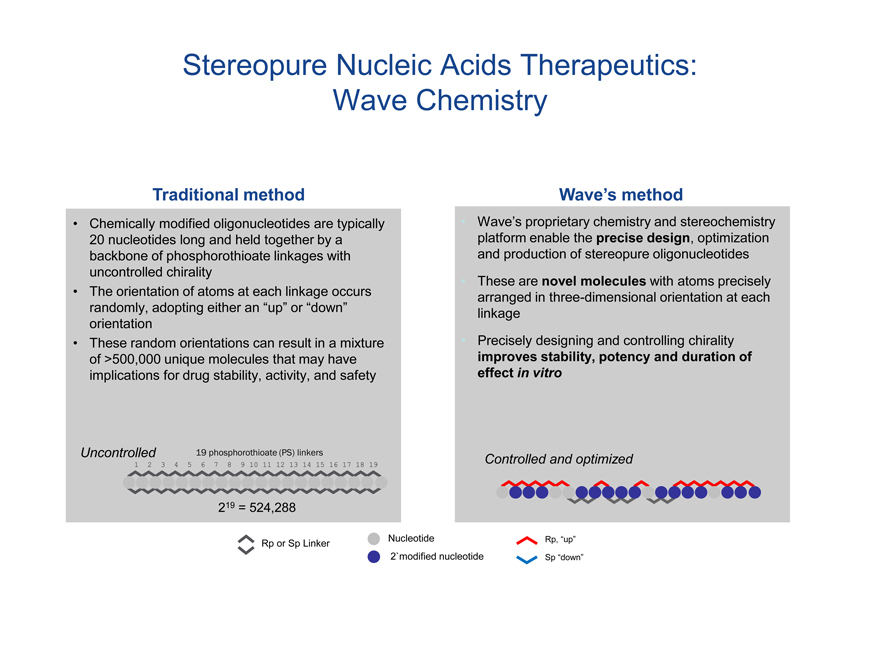
Stereopure Nucleic Acids Therapeutics: Wave Chemistry
Traditional method
• Chemically modified oligonucleotides are typically 20 nucleotides
long and held together by a backbone of phosphorothioate linkages with uncontrolled chirality
• The orientation of atoms at each linkage occurs randomly,
adopting either an “up” or “down” orientation
• These random orientations can result in a mixture of >500,000 unique molecules that may
have implications for drug stability, activity, and safety
Uncontrolled 19 phosphorothioate (PS) linkers
1 2 3 4 5 6 7 8 9 10 11 12 13 14 15 16 17 18 19
219 = 524,288
Wave’s method
Wave’s proprietary chemistry and stereochemistry platform enable the
precise design, optimization and production of stereopure oligonucleotides
These are novel molecules with atoms precisely arranged in three-dimensional orientation
at each linkage
Precisely designing and controlling chirality improves stability, potency and duration of effect in vitro
Controlled and optimized
Nucleotide Rp, “up” Rp or Sp Linker 2`modified nucleotide
Sp “down”
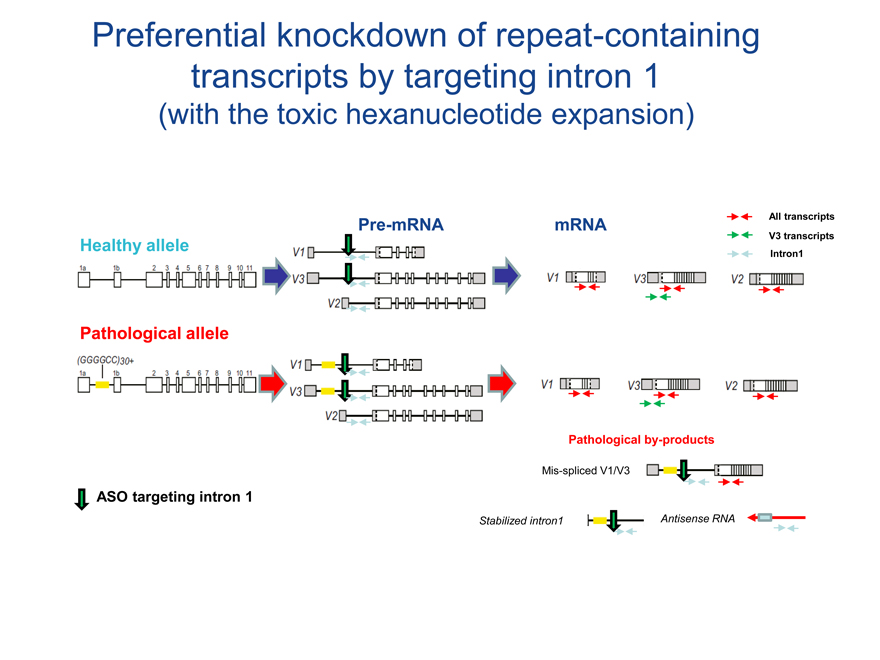
Preferential knockdown of repeat-containing transcripts by targeting intron 1
(with the toxic hexanucleotide expansion)
All transcripts
Pre-mRNA mRNA V3 transcripts
Healthy allele
Intron1
Pathological by-products
Mis-spliced V1/V3
Stabilized intron1 Antisense RNA
ASO targeting intron 1

Screening and lead optimization funnel
Sequence search BioInformatics
CANDIDATE SELECTION ~200 sequences Screening Reporter assay ~10
sequences Profiling PHARMACOLOGY
C9-ALS fibroblasts
Sequence selection C9-ALS neurons
C9-BAC mouse C9 mouse 1ary neurons
Lead Optimization 5-10 leads
Chemistry & Stereochemistry
C9-ALS
neurons & selection in vitro counterscreens
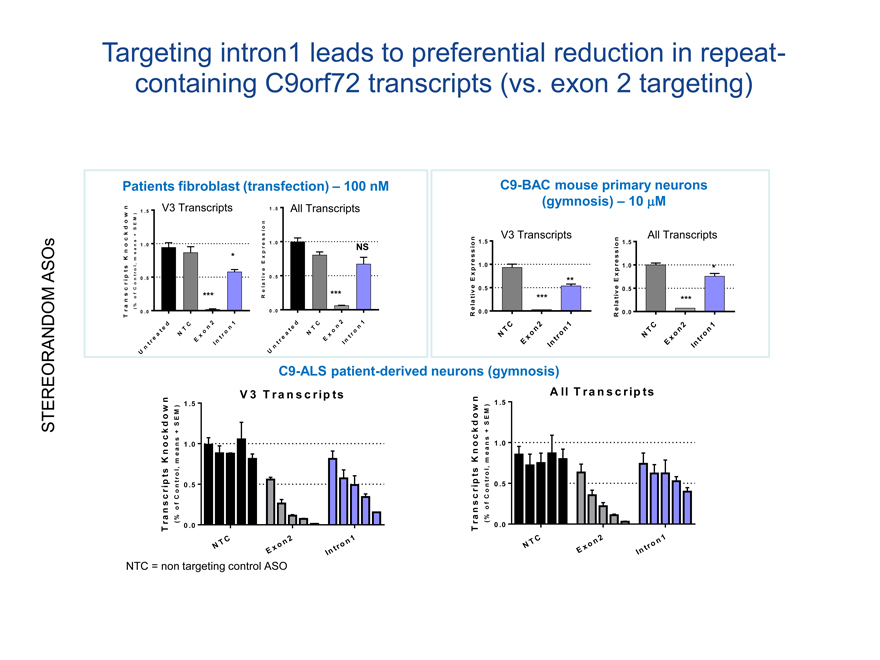
STEREORANDOM ASOs
Targeting intron1 leads to preferential reduction in repeat-containing C9orf72 transcripts (vs. exon 2 targeting)
Patients fibroblast (transfection) – 100 nM C9-BAC mouse primary neurons n 1 . 5 (gymnosis) – 10 mM
1 . 5 V3 Transcripts All Transcripts
V3 Transcripts All Transcripts V3 Transcripts All
Transcripts
C9-ALS patient-derived neurons (gymnosis)
V3 Transcripts All Transcripts
Transcripts knockdown (% of Control, means * SEM) NTC Exon2
Intron 1
NTC = non targeting control ASO
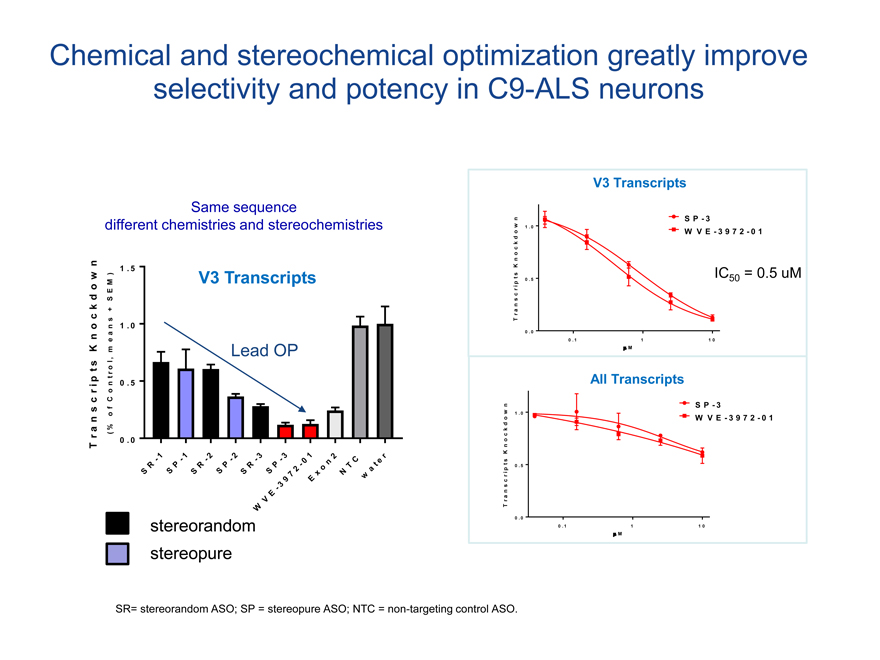
Chemical and stereochemical optimization greatly improve selectivity and potency in C9-ALS neurons
V3 Transcripts V3 Transcripts
Transcripts Knockdown (% of Control, means * SEM) Lead OP SP-3 WVE-3972-01 IC 50 = 0.5 uM
All Transcripts SP-3 WVE-3972-01
Same sequence
Stereorandom stereopure
SR= stereorandom ASO; SP = stereopure ASO; NTC = non-targeting control ASO.
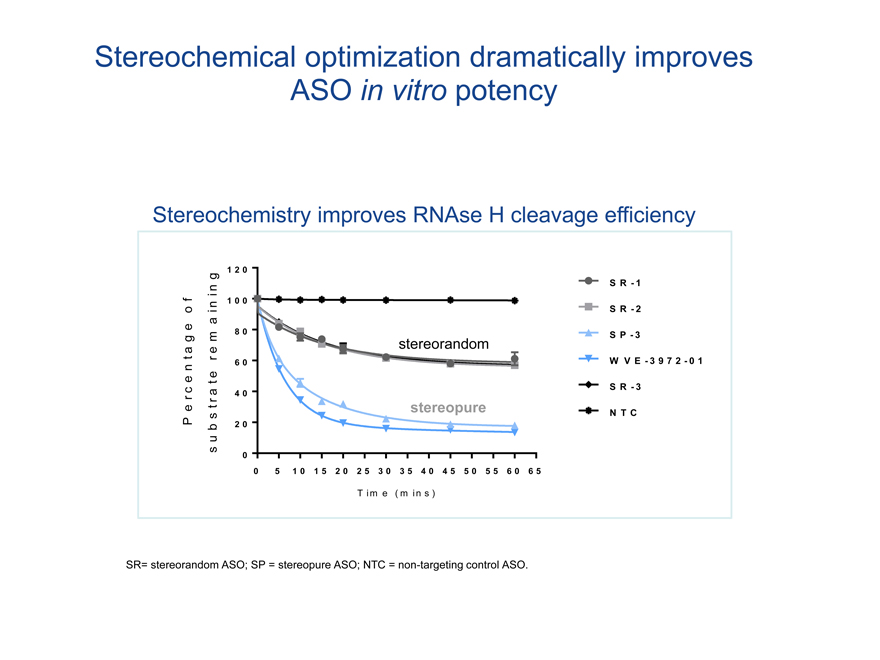
Stereochemical optimization dramatically improves ASO in vitro potency
Stereochemistry improves RNAse H cleavage efficiency
Percentage of substrate remaining 120 100
80 60 40 20 0 0 5 10 15 20 25 30 35 40 45 50 55 60 65
SR-1 SR-2 SP-3 WVE-3972-01 SR-3 NTC time (mins)
SR= stereorandom ASO; SP = stereopure ASO; NTC = non-targeting control ASO.
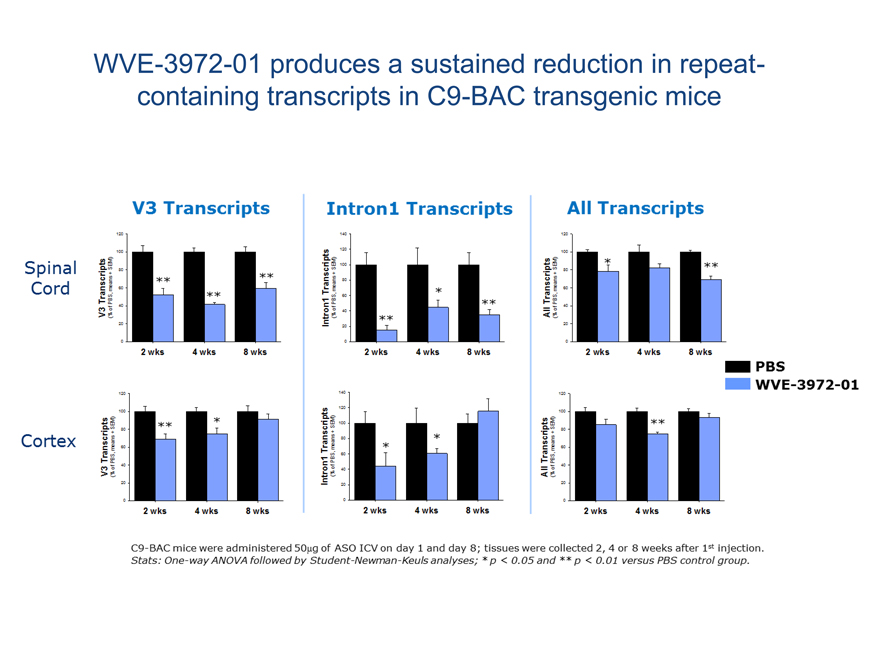
WVE-3972-01 produces a
sustained reduction in repeat-
containing transcripts in C9-BAC transgenic mice
V3 Transcripts Intron 1 Transcripts All Transcripts Spinal Cord
Cortex PBS WVE-3972-01 2 wks 4 wks 8 wks 2 wks 4 wks 8 wks 2 wks 4 wks 8 wks 2 wks 4 wks 8 wks 2 wks 4 wks 8 wks V3 Transcripts V3 Transcripts Intron 1 Transcripts Intron 1 Transcripts
All Transcripts All Transcripts
C9-BAC mice were administered 50ug of ASO ICV on day 1 and day 8; tissues were collected 2,
4 or 8 weeks after 1st injection. Stats: One-way ANOVA followed by strudent-Newman-Keuis analyses * p V 0.01 versus PBS control group
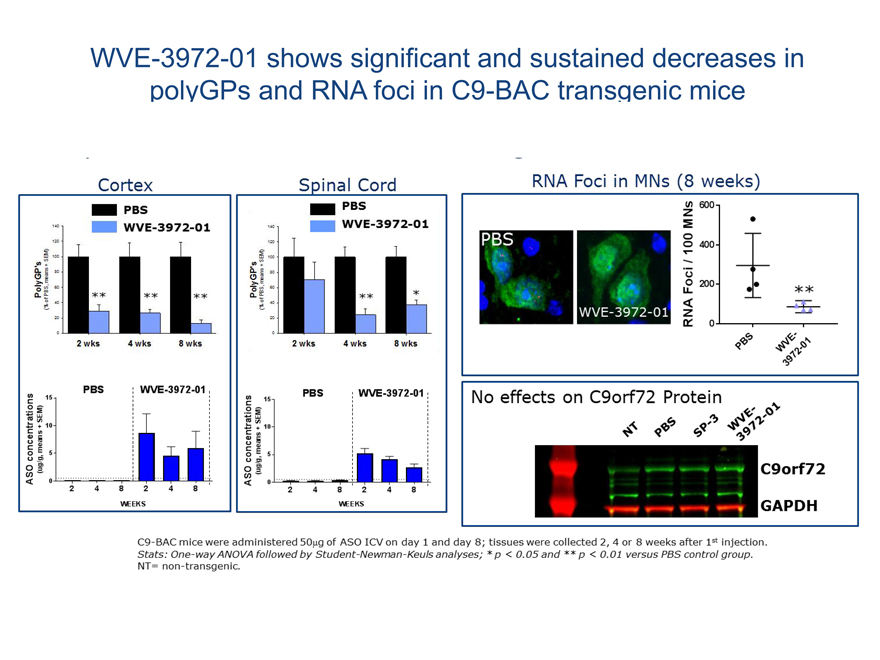
WVE-3972-01 shows significant
and sustained decreases in polyGPs and RNA foci in C9-BAC transgenic mice
Cortex Spinal Cord RNA Foci in MNs (8 weeks)
PBS WVE-3972-01 PBS
WVE-3972-01 PolyGP’s ASO concentration PBS WVE-3972-01 RNA Foci / 100 MNs 0 200 400
600 PBS WVE-3972-01 No effects on C9orf72 Protein NT PBS SP-3
WVE-3972-01 C9orf72 GAPDH
C9-BAC mice were
administered 50ug of ASO ICV on day 1 and day 8; tissues were collected 2, 4 or 8 weeks after 1st injection Stats: One-way ANOVA followed by Student-Newman-Keuls analyses; * p < 0.01 versus PBS control
group. NT = non-transgenic.
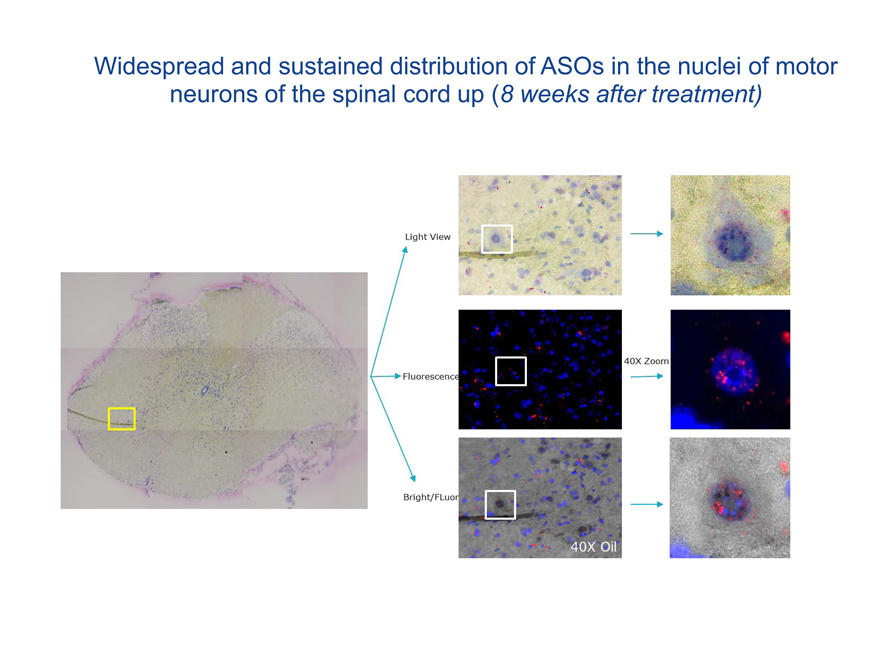
Widespread and sustained distribution of ASOs in the nuclei of motor neurons of the spinal cord up (8 weeks
after treatment)
Light View Fluorescence Bright/Flour 40X Oil 40X Zoom
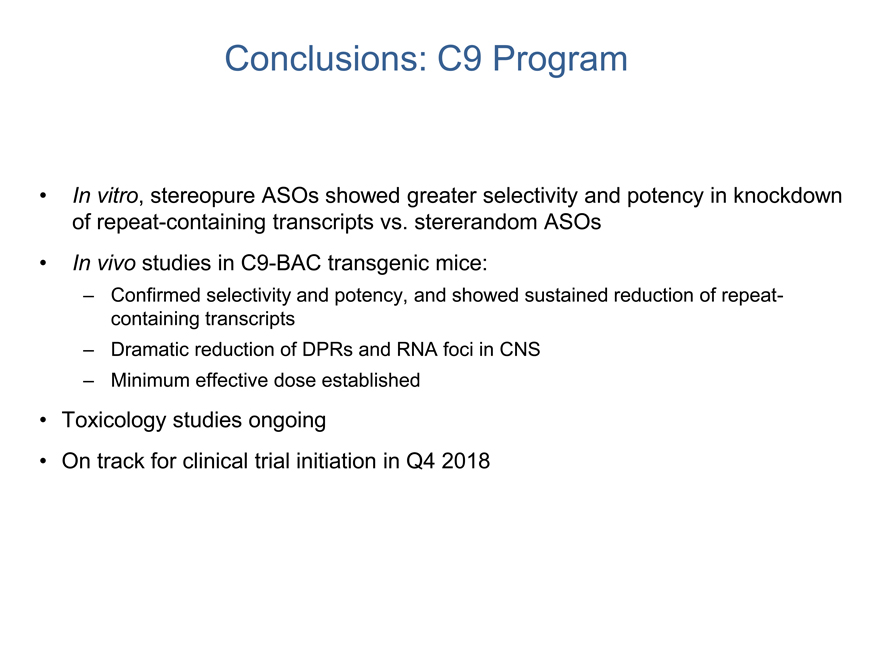
Conclusions: C9 Program
• In vitro, stereopure ASOs showed greater selectivity and potency in knockdown of repeat-containing transcripts vs. stererandom ASOs
• In vivo studies in C9-BAC transgenic mice:
– Confirmed selectivity and potency, and showed sustained reduction of repeat-containing transcripts
– Dramatic reduction of DPRs and RNA foci in CNS
– Minimum effective dose
established
• Toxicology studies ongoing
• On track for clinical
trial initiation in Q4 2018
